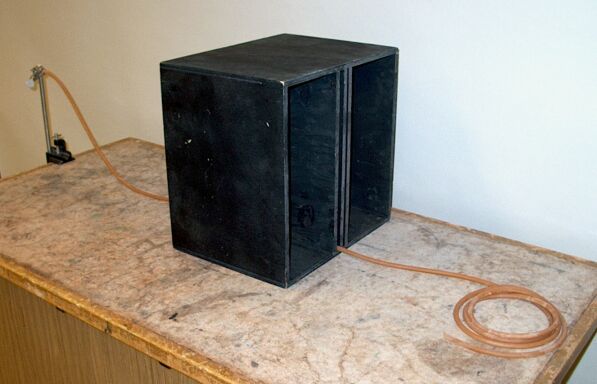
A length of latex rubber tubing is anchored at one end, and passes through a slot in a wooden box, shown oriented vertically in the photograph above. With the box oriented this way, if you pull the tubing taut by the free end and set it oscillating in the vertical direction, the wave passes through the box. If you set the tubing oscillating in the horizontal direction, however, the wave does not pass through the box. You can, of course, switch the orientation of the box if you wish, in which case the wave that oscillates in the horizontal direction passes through, but the wave that oscillates in the vertical direction is blocked.
When you hold the rubber tubing taut and pluck it, or move the free end to set it oscillating, you displace the tubing in a direction perpendicular to that in which the pulse or wave travels toward the other end of the tubing. You create a transverse wave. Electromagnetic radiation, or light, consists of an oscillating electric field and an oscillating magnetic field (oscillating in phase with each other), whose directions of oscillation are perpendicular to each other and to the direction in which the light travels. (See this page at HyperPhysics for an illustration.) An electromagnetic wave is thus also a transverse wave. As the wave propagates, the oscillating electric vector and magnetic vector travel in perpendicular planes that intersect at the line along which the wave travels. Because of this property, an electromagnetic wave is said to be plane polarized.
Depending on the source, the electric vector of the electromagnetic waves it emits may have a particular orientation, in which case the radiation is said to be polarized. If the source produces waves for which the electric vector is randomly oriented, the radiation is unpolarized. It is possible to select light that is polarized in a particular direction, either by reflection at Brewster’s angle as shown in demonstration 84.39 -- Polarization of reflected light, or by passing it through a material that has special optical properties, usually some type of polarizing sheet. (See demonstration 84.36 -- Polarizers.) Probably the most common material used to make such a sheet is stretched polyvinyl alcohol doped with iodine. Stretching the material aligns the polymer chains so that they all run parallel to each other. The iodine that is then added to the material forms linear chains of iodine molecules within the chains of polyvinyl alcohol. This thin polymer layer is then sandwiched between clear layers of cellulose triacetate or similar plastic. (See, for example, here or here.) The chains of iodine-doped polymer interact strongly with light whose electric vector is parallel to them, but not at all with light whose electric vector is perpendicular to them. Thus, light whose electric vector is parallel to the polymer chains is absorbed or blocked, and light whose electric vector is perpendicular to them passes through. The direction along which the electric vector lies for light that the polarizer allows to pass, is called the easy axis of the polarizer. Light whose electric vector is perpendicular to the easy axis is blocked by the polarizer.
The box shown above is analogous to a polarizing sheet with its easy axis vertically oriented, and the oscillating Latex tubing is analogous to an electromagnetic wave incident on a polarizing sheet. The tubing passes through a gap between two boards set in the middle of the box, which as noted above sits in the vertical plane. With the box in this orientation, if you set the tubing oscillating up and down, the wave can pass through the slot. If, however, you set the tubing oscillating from side to side, the slot blocks the sideways motion of the tubing, and the wave cannot pass through to the other side of the box. The box passes a wave that is vertically polarized, but not one that is horizontally polarized. If you turn the box 90 degrees, it then passes a horizontally polarized wave, but not a vertically polarized one.
If the electric vector of an electromagnetic wave is neither parallel nor perpendicular to the easy axis of a polarizer, it possesses two components, one parallel to the easy axis, and one perpendicular to it. The polarizer passes the component that is parallel to its easy axis, and blocks the component that is perpendicular to it. (See demonstration 84.36 -- Polarizers.) Though friction between the tubing and the box, and the geometry of the system, prevent you from showing this, this demonstration allows you to show clearly what a transverse wave is, and to illustrate the property of polarization.